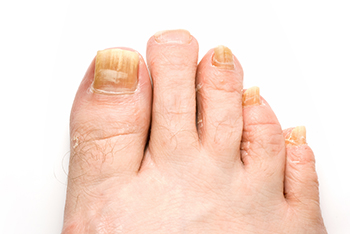
Fungal infections can develop underneath the toenail surface, often as a result of other fungal foot infections. Fungal nails, or onychomycosis, can be harder to treat than other foot fungi, such as athlete’s foot; they can be accompanied by bacterial and/ or yeast infections that affect the nail plate as a result of the fungal infection, and they may spread to affect other toenails, fingernails, and areas of skin.
Oftentimes, people are unaware that they have a fungal nail problem. Symptoms can be brittle, thickened, discolored nails that may loosen and crumble as the fungal problem advances. White spots on the nail surface can also indicate fungal nails. People with chronic diseases that impact the immune system, such as immune deficiencies, diabetes, and circulatory problems, are more susceptible to fungal nails.
Fungal nails and foot fungal infections can be prevented by the following suggestions:
- Wash and dry feet thoroughly, taking extra care to dry between the toes
- Use powder to keep the feet dry
- Keep socks and footwear clean and dry; socks can be changed several times daily
- Wear footwear made of breathable materials that allow air to circulate around the feet; constricting footwear, stockings, and socks can trap moisture and perspiration on the feet
- Never share socks or footwear
- Do not walk barefoot in public areas such as showers, pools, and locker rooms; instead, wear plastic flip-flops, slides, or shower shoes
- Sanitize nail clippers, nail files, and pedicure instruments; never share them with others
- Avoid injuring the toenails and nail beds, which can eventually develop into an infection
- If over-the-counter treatments do not arrest the fungus or if chronic fungal nail is an issue, prescription treatments administered orally or topically may be necessary (always consult a doctor before taking any type of medication). Debridement can remove the infected nail matter. With aggressive fungal nail cases, a doctor may have to permanently remove the toenail.
